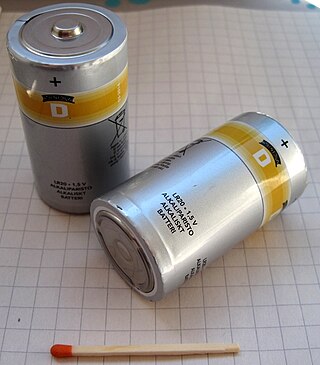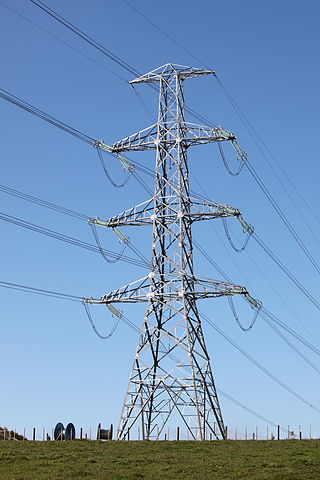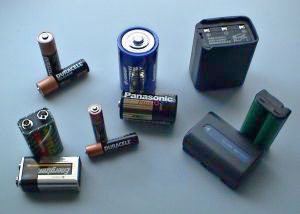
In electricity generation, a generator is a device that converts motion-based power or fuel-based power into electric power for use in an external circuit. Sources of mechanical energy include steam turbines, gas turbines, water turbines, internal combustion engines, wind turbines and even hand cranks. The first electromagnetic generator, the Faraday disk, was invented in 1831 by British scientist Michael Faraday. Generators provide nearly all the power for electrical grids.

A rechargeable battery, storage battery, or secondary cell, is a type of electrical battery which can be charged, discharged into a load, and recharged many times, as opposed to a disposable or primary battery, which is supplied fully charged and discarded after use. It is composed of one or more electrochemical cells. The term "accumulator" is used as it accumulates and stores energy through a reversible electrochemical reaction. Rechargeable batteries are produced in many different shapes and sizes, ranging from button cells to megawatt systems connected to stabilize an electrical distribution network. Several different combinations of electrode materials and electrolytes are used, including lead–acid, zinc–air, nickel–cadmium (NiCd), nickel–metal hydride (NiMH), lithium-ion (Li-ion), lithium iron phosphate (LiFePO4), and lithium-ion polymer.

A flashlight (US) or electric torch (CE), usually shortened to torch, is a portable hand-held electric lamp. Formerly, the light source typically was a miniature incandescent light bulb, but these have been displaced by light-emitting diodes (LEDs) since the early 2000s. A typical flashlight consists of the light source mounted in a reflector, a transparent cover to protect the light source and reflector, a battery, and a switch, all enclosed in a case.
A primary battery or primary cell is a battery that is designed to be used once and discarded, and not recharged with electricity and reused like a secondary cell. In general, the electrochemical reaction occurring in the cell is not reversible, rendering the cell unrechargeable. As a primary cell is used, chemical reactions in the battery use up the chemicals that generate the power; when they are gone, the battery stops producing electricity. In contrast, in a secondary cell, the reaction can be reversed by running a current into the cell with a battery charger to recharge it, regenerating the chemical reactants. Primary cells are made in a range of standard sizes to power small household appliances such as flashlights and portable radios.

Trevor Graham Baylis was an English inventor best known for the wind-up radio. The radio, instead of relying on batteries or external electrical source, is powered by the user winding a crank. This stores energy in a spring which then drives an electrical generator. Baylis invented it in response to the need to communicate information about AIDS to the "people of Africa". He ran a company in his name dedicated to helping inventors to develop and protect their ideas and to find a route to market.
Energy harvesting (EH) – also known as power harvesting,energy scavenging, or ambient power – is the process by which energy is derived from external sources, then stored for use by small, wireless autonomous devices, like those used in wearable electronics, condition monitoring, and wireless sensor networks.

A D battery is a standardized size of a dry cell. A D cell is cylindrical with an electrical contact at each end; the positive end has a nub or bump. D cells are typically used in high current drain applications, such as in large flashlights, radio receivers, and transmitters, and other devices that require an extended running time. A D cell may be either rechargeable or non-rechargeable. Its terminal voltage and capacity depend upon its cell chemistry.

A mechanically powered flashlight is a flashlight that is powered by electricity generated by the muscle power of the user, so it does not need replacement of batteries, or recharging from an electrical source. There are several types which use different operating mechanisms. They use different motions to generate the required power; such as squeezing a handle, winding a crank, or shaking the flashlight itself. These flashlights can also be distinguished by the technique used to store the energy: a spring, a flywheel, a battery or a capacitor.

Electric power is the rate of transfer of electrical energy within a circuit. Its SI unit is the watt, the general unit of power, defined as one joule per second. Standard prefixes apply to watts as with other SI units: thousands, millions and billions of watts are called kilowatts, megawatts and gigawatts respectively.

Eveready Industries India Ltd. (EIIL) is an Indian company that manufactures and markets batteries and lighting products. The Eveready brand has been present in India since 1905. It also manufactures photogravure plates, castings, carbon electrodes and related products.

A rechargeable alkaline battery, also known as alkaline rechargeable or rechargeable alkaline manganese (RAM), is a type of alkaline battery that is capable of recharging for repeated use. The formats include AAA, AA, C, D, and snap-on 9-volt batteries. Rechargeable alkaline batteries are manufactured fully charged and have the ability to hold their charge for years, longer than nickel-cadmium and nickel-metal hydride batteries, which self-discharge. Rechargeable alkaline batteries can have a high recharging efficiency and have less environmental impact than disposable cells.

A batteryless radio is a radio receiver which does not require the use of a battery to provide it with electrical power.
An emergency radio is, broadly speaking, a radio receiver designed to remain functional in cases of power outage or isolation from contact with civilization. Such radios are often designed to run on minimal or renewable power sources, such as solar.

A dynamo is an electrical generator that creates direct current using a commutator. Dynamos were the first electrical generators capable of delivering power for industry, and the foundation upon which many other later electric-power conversion devices were based, including the electric motor, the alternating-current alternator, and the rotary converter.

Human power is the rate of work or energy that is produced from the human body. It can also refer to the power of a human. Power comes primarily from muscles, but body heat is also used to do work like warming shelters, food, or other humans.

A solar charger is a charger that employs solar energy to supply electricity to devices or batteries. They are generally portable.

An electric battery is a source of electric power consisting of one or more electrochemical cells with external connections for powering electrical devices. When a battery is supplying power, its positive terminal is the cathode and its negative terminal is the anode. The terminal marked negative is the source of electrons that will flow through an external electric circuit to the positive terminal. When a battery is connected to an external electric load, a redox reaction converts high-energy reactants to lower-energy products, and the free-energy difference is delivered to the external circuit as electrical energy. Historically the term "battery" specifically referred to a device composed of multiple cells; however, the usage has evolved to include devices composed of a single cell.
Lifeline Energy is a non-profit social enterprise that provides technology solutions for off-grid learning. The organization designs, manufactures and distributes solar and wind-up media players and radios for classroom and group listening and was behind the first solar and wind-up radio for humanitarian use which launched in 2003. Since it began operations in 1999 more than 550,000 wind-up and solar powered radios and media players have been distributed, mainly in sub-Saharan Africa. Millions of listeners have been reached, as classrooms of up to 60 children or listening groups can use each radio or media player.

Solar powered flashlights or solar powered torches are flashlights powered by solar energy stored in rechargeable batteries. Most of these flashlights use light-emitting diodes lamps since they have lower energy consumption compared to incandescent light bulbs.

Home energy storage devices store electricity locally, for later consumption. Electrochemical energy storage products, also known as "Battery Energy Storage System", at their heart are rechargeable batteries, typically based on lithium-ion or lead-acid controlled by computer with intelligent software to handle charging and discharging cycles. Companies are also developing smaller flow battery technology for home use. As a local energy storage technologies for home use, they are smaller relatives of battery-based grid energy storage and support the concept of distributed generation. When paired with on-site generation, they can virtually eliminate blackouts in an off-the-grid lifestyle.
















